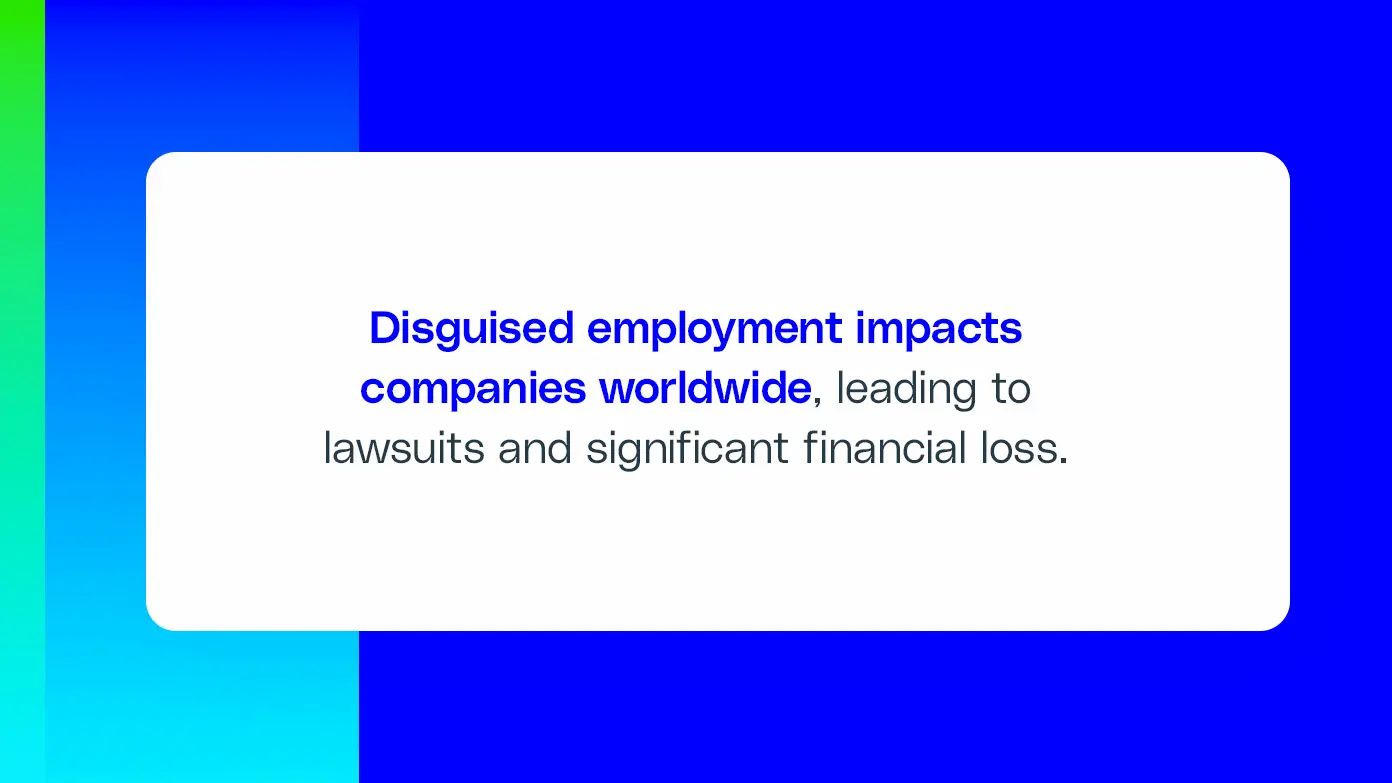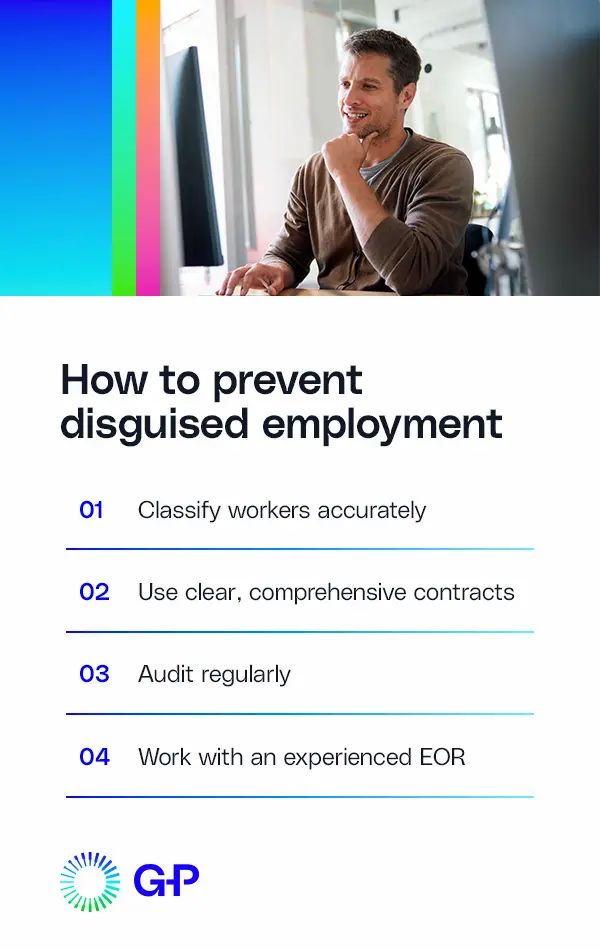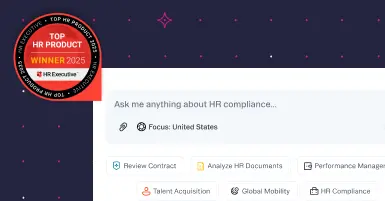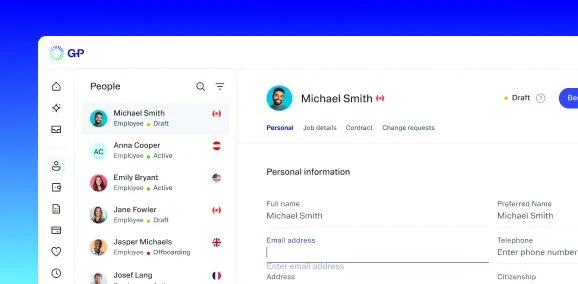Companies turn to global contractors to speed expansion and deliver projects on time and on budget. But the laws surrounding this worker type vary across jurisdictions. A small misstep can trigger misclassification.
Independent contractor misclassification, also called disguised employment, is illegal, regardless of intentionality. It's important to understand employee classification laws to avoid penalties.
Key takeaways
What it is: Disguised employment happens when a company hires a person as a contractor but treats them like an employee. This creates significant compliance risks.
Why it matters: Worker misclassification can lead to fines and reputational damage.
How to avoid it: Correctly classify workers, use clear contracts, run audits, and partner with a global employment expert like G-P™.
What is disguised employment?
Disguised employment means a person is hired as an independent contractor but treated like an employee. The definition of disguised employment varies from country to country, so it's important to understand local labor laws.
Each jurisdiction has a unique process for classifying workers. For example, the U.S. considers the degree of control a worker has over how and when they perform work to determine their status. Some states, like California, have stricter classification systems than other states.
The U.S. generally has less prescriptive employee classification requirements than European countries. For example, in Germany, "personal dependence" is central when classifying workers. Personal dependence is the degree of subordination. This includes many factors, such as whether the worker is subject to entrepreneurial risk, economic dependence, or integrated into the company's culture.
Real-world examples of disguised employment

Disguised employment impacts companies worldwide, leading to lawsuits and significant financial loss. Real-world examples include:
Uber
Uber faces ongoing global lawsuits over disguised employment. For example, the Brussels Labor Court recently confirmed subordination between a driver and Uber. They required Uber to classify the driver as an employee.
In Ontario, Uber faces a class action lawsuit for misclassifying drivers and failing to pay minimum wage and benefits.
Authorities in several countries have classified Uber drivers as employees due to subordination. Uber controls when and how a person performs their work, and how much they charge. This level of control indicates an employer-employee relationship.
Glovo
Glovo, a food delivery company operating in Spain, has been fined millions of euros since Spain passed the Riders Law. The Riders Law requires delivery riders to be classified as employees. Glovo misclassified riders as self-employed and didn't follow other local labor laws.
Arise Virtual Solutions Inc.
In a U.S. case affecting over 22,000 workers, the Department of Labor (DOL) sued Arise Virtual Solutions, Inc. Arise subjected contractors to a strict scheduling policy and required them to pay for mandatory training. The company violated other labor laws and is expected to pay back wages and liquidated damages.
How to recognize disguised employees
Review the following areas to identify disguised employees.
1. Schedule management
Do contractors have control over when and how they work? Or does your company give contractors a set schedule and detailed instructions on how to complete tasks? If your contractors don't have significant control over their schedules, they may be misclassified.
2. Non-compete agreements
Non-compete agreements prohibit professionals from working for competitors for a specific time. In some jurisdictions, non-compete laws impact worker classification.
For instance, in Germany and France, non-compete agreements can suggest an employee-like relationship. That's because non-competes limit a contractor's freedom, which indicates a subordinate relationship.
Review your contracts and non-compete agreements, and consider if they comply with local labor laws. Generally, non-competes with short durations are often seen as a reasonable business protection. Agreements with a narrower geographic scope are also less likely to indicate an employee-employer relationship. Still, non-competes could contribute to a worker misclassification claim if other factors are present.
3. Company equipment

Do your contractors have to use company equipment? That's a strong indicator that they're misclassified because it shows a lack of autonomy and economic dependence.
As the DOL states, independent contractors are in "business for themselves." So, they should be in control of their work equipment. Contractors invest in equipment to grow their business and stay autonomous. Requiring contractors to use company equipment suggests you're directing not only how they work but also with what resources.
4. Integration into company culture
Do your contractors attend company meetings, team-building activities, and holiday events? Do they use company software, vehicles, networks, or email addresses?
Integrating contractors into your company culture suggests worker misclassification. Integration could indicate subordination — a red flag for worker misclassification in many jurisdictions.
The importance of avoiding disguised employment
Companies that incorrectly classify employees deny them certain rights. This can have many consequences for employers.
1. Fines and penalties
Employers may have to retroactively pay costs related to an employee relationship. This includes:
-
Back taxes
-
Unpaid wages
-
Compensation for benefits
-
Interest on unpaid taxes
Employers may also be charged criminally for worker misclassification. For instance, in Australia, employers who commit wage theft face large fines, imprisonment, or both. Wage theft is when an employer intentionally fails to pay employees their full legal entitlements, such as wages, superannuation, overtime, and leave. Wage theft is often a result of worker misclassification.
2. Reputational damage
Worker misclassification impacts public perception. Reputational damage has several implications, including difficulty in attracting talent and business partners. Ultimately, when worker misclassification harms your company's reputation, it can impact growth.
3. Operational disruptions or mandated shutdowns
In some jurisdictions, authorities can shut down operations due to alleged disguised employment. This is the case in New Jersey, where worker misclassification has severe penalties, like stop-work orders.
The New Jersey Department of Labor and Workforce Development has issued 192 stop-work orders since 2019. The Department may lift stop-work orders when penalties and back wages are paid.
No matter where you run your business, worker misclassification can slow down or disrupt operations. HR teams get weighed down by the administrative burden of audits and legal proceedings. Worker misclassification may also overhaul your payroll and benefits system. Lastly, talent retention rates can drop if workers discover disguised employment in your organization.
How to prevent disguised employment

Before engaging with independent contractors, use these tips to avoid disguised employment.
1. Classify workers accurately
Assess contractors and local employment laws carefully to determine the correct worker classification. Consider the following:
-
Will the contractor work for other companies or have an exclusive relationship with your company?
-
Will they need mandatory training?
-
Will they be bound to company policies and procedures?
-
Are their services essential to your company's functioning?
-
Will you monitor or supervise their performance?
-
Can they choose when, where, and how they perform their work?
-
Will they use their own equipment and supplies?
-
Is the relationship project-based or long-term/indefinite?
While each country has specific criteria for classifying workers, control is a key factor. The above questions will help you determine your company's level of control. That said, it's crucial to research and understand local laws to avoid disguised employment.
2. Use clear, comprehensive contracts
Once you hire contractors, you must draft independent contractor agreements that align with local labor laws. Generally, these contracts achieve the following:
-
Explicitly state the intended relationship as an independent contractor and not an employee.
-
Clearly define the scope of work, project timelines, and payment terms.
-
State that the contractor has control of when, how, and where they perform work.
-
Avoid language that implies the contractor will be managed or supervised.
-
State that the contractor is responsible for their operational expenses, including equipment.
-
Clearly explain who owns the intellectual property generated under the agreement.
-
State that the contractor isn’t eligible for employee benefits.
-
Clarify the termination and renewal process.
-
Include provisions on non-exclusivity and permissible delegation.
Use G-P Gia™ to review and/or draft compliant services agreements for contractors. Gia is an AI-powered global HR agent that answers your toughest compliance questions and automates policy management from creation to review. Built on a proprietary knowledge base, Gia reviews contracts for compliance across 50 countries and all 50 U.S. states. With Gia's automated compliance checks and up-to-date information, you can cut the time and costs of compliance by up to 95%.
3. Audit regularly
Regularly monitor contractor relationships to make sure they align with regulations. Look for signs of growing oversight or daily involvement, such as integration into your company culture.
Stay current on local employment laws, as worker classification regulations continually update. Amend contracts as needed to reflect the actual relationships between your company and the contractor.
4. Work with an experienced employer of record (EOR)
An EOR acts as the legal employer on behalf of a company. Partnering with an EOR allows you to build global teams, without setting up new entities. EORs understand complex employment laws and stay current with regulatory changes. Industry-leading EORs like G-P offer parallel services to help companies hire and pay both contractors and employees.
G-P is the go-to EOR for companies looking for a quick and compliant way to build global workforces. With G-P EOR, you can easily convert international contractors to employees, if needed.
How G-P ensures compliant global hiring
G-P is the undisputed leader in global employment technology. Our compliance expertise and presence in 180+ countries simplify global hiring for companies of all sizes.
We created G-P Contractor™ to streamline global contractor hiring and payment. Use G-P Contractor to pay contractors in minutes from a centralized platform. Our technology combines AI with our HR, tax, and legal expertise to help you reduce compliance risk.
Hire contractors and employees with G-P
Worker classification laws are complex and ever-changing. Avoiding disguised employment helps protect your company from liabilities and operational disruption.
G-P lets you hire international contractors and employees with confidence. With our compliance expertise and innovative technology, we make it easy to expand globally.





















